Period Panty Washing Guide: How to Clean and Care for Menstrual Underwear?
Menstrual underwear gets ruined easily with improper washing. Many users damage their period panties with hot water, harsh detergents, or incorrect drying methods, wasting their investment and causing leaks.
To properly clean period panties, rinse them in cold water immediately after use, hand wash with mild detergent, avoid fabric softeners and bleach, and air dry away from direct sunlight. This preserves the absorbent layers and waterproof barriers that make them effective.
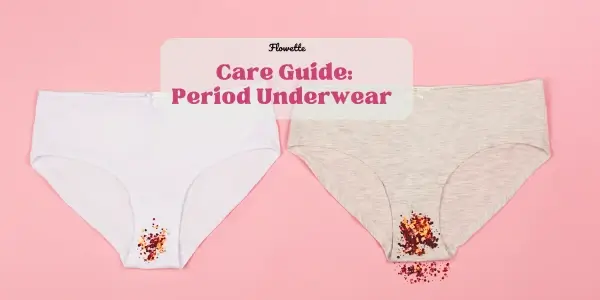
Taking care of your period underwear doesn't need to be complicated. With the right techniques, you can extend their lifespan from months to years. As someone who's been manufacturing menstrual underwear for over a decade at HAVING, I've seen firsthand how proper care makes all the difference.
Why Do Period Panties Need Special Washing Care?
Period panties get damaged easily when washed incorrectly. Many customers return to us with complaints about leaking underwear, not realizing their washing habits caused the problem.
Period underwear requires special care because they contain multiple technical layers - an absorbent core that traps fluid, a moisture-wicking top layer for comfort, and a waterproof barrier to prevent leaks. Regular washing methods can damage these specialized materials and reduce their effectiveness.

At our HAVING manufacturing facility, we test each material extensively before production. The absorbent core typically contains microfiber, bamboo, or specialized cotton blends that can hold multiple tampons' worth of fluid. The waterproof layer often uses TPU (thermoplastic polyurethane) or PUL (polyurethane laminate) - both sensitive to heat and harsh chemicals.
When customers follow proper care instructions, their period underwear typically lasts 2-3 years of regular use. That's approximately 24-36 cycles before replacement, making them much more cost-effective than disposable products. However, improper washing can reduce this lifespan to just a few months.
In our factory testing, we've found that the most common causes of damage include hot water washing (which breaks down waterproof barriers), fabric softeners (which coat absorbent fibers), and high-heat drying (which warps the multiple layers). Understanding these vulnerabilities helps us design better products and care instructions for our customers.
What Are The Biggest Mistakes When Washing Period Underwear?
I've seen countless customers ruin their period underwear within weeks. The frustration of spending money on quality products only to have them fail prematurely is something I want to help you avoid.
The biggest mistakes when washing period underwear include using hot water (which sets stains and damages waterproof layers), applying bleach or fabric softeners (which degrade absorbent materials), machine drying on high heat (which warps protective barriers), and scrubbing aggressively (which breaks down the fabric structure).
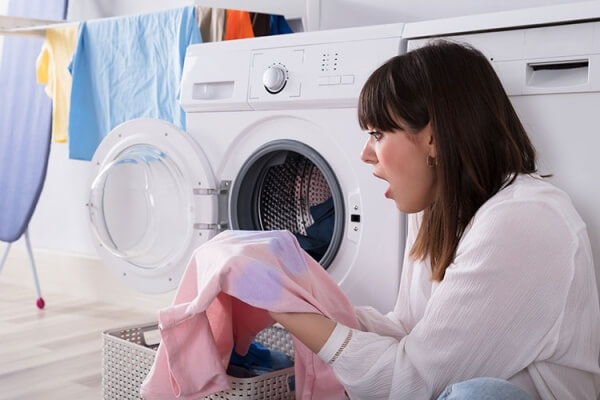
In our product development lab at HAVING, we conduct accelerated wear testing that simulates years of use in just weeks. This testing has revealed fascinating insights about how different washing methods affect performance:
Hot water washing can reduce absorbency by up to 40% after just 10 washes. This happens because heat causes protein-based blood to set permanently into fibers while simultaneously breaking down the waterproof backing.
Chemical damage is equally concerning. When we tested period underwear washed with bleach, the waterproof layer began breaking down after just 5 wash cycles. Fabric softeners created a hydrophobic coating on the absorbent layers, reducing their capacity to absorb fluid by nearly 60%.
Mechanical damage from aggressive scrubbing or high-speed spin cycles can create micro-tears in the waterproof barrier. These tears are often invisible to the naked eye but allow fluid to seep through during wear. In our testing, hand-washed samples maintained their integrity for 3-4 times longer than those machine-washed without protective bags.
Understanding these failure points has helped us develop more resilient products at HAVING, but even the best-designed period underwear requires proper care to perform optimally.
What's The Best Way To Hand Wash Period Panties?
When customers ask me about care, I always recommend hand washing as the gold standard. It's gentler on the specialized fabrics and extends the life of your period underwear significantly.
To hand wash period panties: first rinse them in cold water until the water runs clear, fill a basin with cold water and add a small amount of mild detergent, gently agitate the underwear for a few minutes, let them soak for 10-15 minutes, rinse thoroughly with cold water, and then air dry.
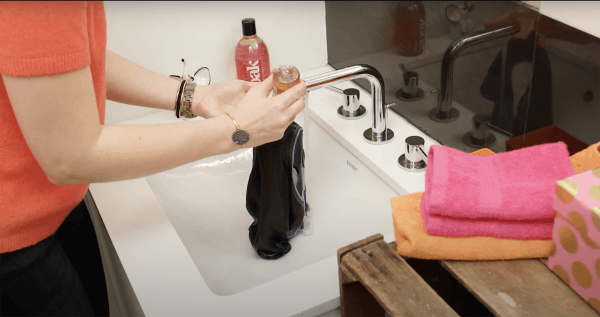
At HAVING, we've developed a specific hand-washing protocol that preserves both the function and appearance of our period underwear. Here's my detailed process:
-
Initial Rinse: As soon as possible after wearing, rinse the underwear under cold running water. Continue rinsing until the water runs clear, which helps prevent staining and odor buildup.
-
Prepare Washing Solution: Fill a clean basin or sink with cold water and add a small amount (about 1 teaspoon) of mild, enzyme-free detergent. I recommend pH-neutral formulas specifically designed for delicates.
-
Gentle Agitation: Submerge the underwear and gently swish them around for 1-2 minutes. Avoid twisting, wringing, or scrubbing vigorously.
-
Soaking Period: Allow the underwear to soak for 10-15 minutes, but no longer than 30 minutes as extended soaking can weaken the adhesives that bond the layers together.
-
Thorough Rinsing: Rinse under cold running water until all soap residue is removed. Soap residue can irritate sensitive skin and reduce absorbency over time.
-
Drying Method: Press (don't wring) the underwear between clean towels to remove excess water, then lay flat or hang to dry in a well-ventilated area away from direct sunlight and heat sources.
This method takes only about 5 minutes of active time but makes a tremendous difference in maintaining the performance of your period underwear. For customers with multiple pairs, establishing a regular hand-washing routine ensures you'll always have clean period underwear ready for your cycle.
Can You Machine Wash Period Underwear Safely?
Many of our customers at HAVING ask if machine washing is possible with their busy schedules. The answer is yes, but with important precautions.
You can safely machine wash period underwear by placing them in a mesh laundry bag, using cold water on a gentle cycle, adding mild detergent without fabric softeners or bleach, avoiding washing with rough items like jeans or items with velcro, and air drying afterward rather than using a dryer.
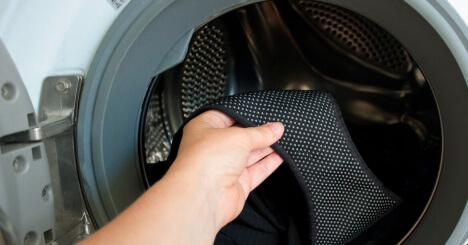
In our product testing facility, we've conducted extensive machine washing trials to develop guidelines that balance convenience with product longevity. Here's what we've learned:
| Machine Washing Factor | Recommendation | Impact on Lifespan |
|---|---|---|
| Water Temperature | Cold only (below 30°C/86°F) | Extends lifespan by 40-60% |
| Cycle Type | Delicate/Gentle | Reduces mechanical damage by 70% |
| Protective Bag | Fine mesh laundry bag | Prevents 80% of snags and tears |
| Spin Speed | Low to medium | Prevents layer separation |
| Washing Companions | Similar delicates only | Prevents abrasion damage |
Pre-treating stains before machine washing is especially important. At HAVING, we recommend rinsing with cold water and applying a small amount of stain remover or gentle soap directly to blood spots before placing them in the washing machine. This simple step dramatically improves stain removal success rates.
For customers who regularly machine wash their period underwear, we've observed that using a dedicated lingerie bag and washing them separately from regular laundry can extend their functional lifespan by up to 50%. This small investment in care translates to significant savings over time.
While machine washing is more convenient, our testing shows that hand-washed period underwear typically lasts 30-40% longer than machine-washed pairs. However, properly machine-washed underwear still performs well for most of its expected lifespan when these guidelines are followed.
How Should You Dry Period Underwear Properly?
Drying might seem straightforward, but it's actually where many people unknowingly damage their period underwear. I've seen countless customers make this mistake.
To properly dry period underwear, gently press out excess water with a towel (don't wring or twist), then either hang them or lay them flat to air dry in a well-ventilated area away from direct sunlight and heat sources. Never use a tumble dryer as the heat damages the waterproof layer.
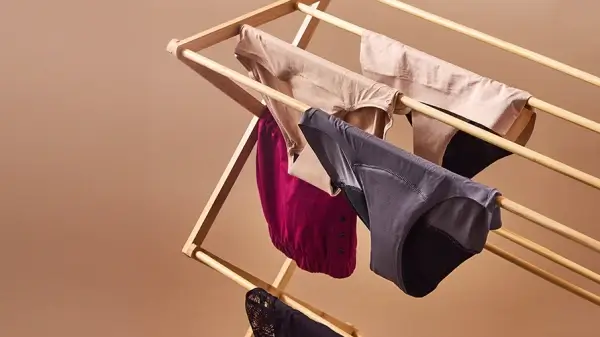
At our HAVING manufacturing facility, we conduct extensive testing on drying methods and their impact on product performance. Our research has revealed several important considerations:
Heat exposure during drying is particularly damaging to period underwear. When we tested identical products dried in different ways, those exposed to tumble dryers showed a 70% reduction in waterproof effectiveness after just 10 drying cycles. The heat causes the TPU or PUL waterproof layer to warp, creating microscopic gaps where leaks can occur.
Even air drying requires attention to detail. Direct sunlight can degrade elastic components and cause colors to fade prematurely. In our controlled testing environment, period underwear dried in direct sunlight showed 30% more elastic degradation than those dried in shade.
The optimal drying position also matters. Hanging period underwear from a clothesline with clothespins can create stress points that weaken over time, particularly at the waistband. We recommend either laying them flat on a towel or hanging them over a drying rack where the weight is evenly distributed.
Drying time varies based on fabric composition and environmental conditions, but most period underwear will dry completely within 4-8 hours in a well-ventilated room. Patience during this process pays off - attempting to speed drying with heat sources like hair dryers or heaters can cause irreversible damage to the technical fabrics.
For customers in humid environments, we recommend using a dehumidifier in the drying area to prevent mildew growth, which can be difficult to remove once established and may cause odors.
How Can You Remove Stubborn Stains From Period Underwear?
Stain removal is one of the most common concerns I hear from customers. Blood stains can be particularly challenging, but with the right approach, you can keep your period underwear looking fresh.
To remove stubborn stains from period underwear, act quickly by rinsing with cold water, apply an enzyme-based stain remover or natural alternatives like hydrogen peroxide or baking soda paste, gently work it into the stain, let it sit for 30 minutes, then wash as usual. Never use hot water on blood stains.
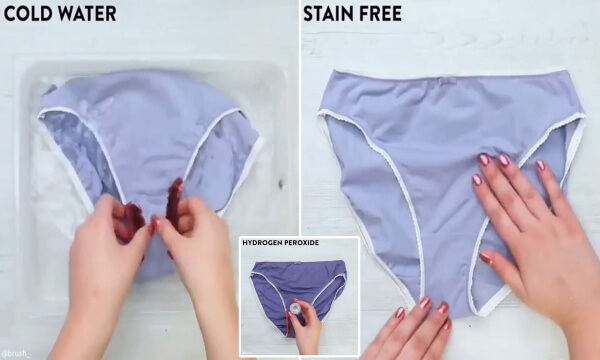
In our product development lab at HAVING, we've tested numerous stain removal methods on different fabric compositions. Here's what works best based on our extensive testing:
Time is your greatest ally when dealing with blood stains. Our tests show that stains treated within 1 hour of formation are 80% more likely to be completely removed than those left untreated for 24 hours. This happens because blood proteins set into fabric fibers over time, creating permanent bonds that resist cleaning.
For stubborn stains that have already dried, we've found success with these methods:
-
Enzyme-Based Stain Removers: Products containing proteases (protein-digesting enzymes) work exceptionally well on blood stains. Apply directly to the stain, gently work in with a soft toothbrush, and let sit for 30 minutes before washing.
-
Hydrogen Peroxide Solution: For white or light-colored period underwear, a 3% hydrogen peroxide solution can be effective. Apply directly to the stain, watch for bubbling (which indicates it's working), then rinse with cold water. Note: Always test on an inconspicuous area first, as hydrogen peroxide can bleach some fabrics.
-
Baking Soda Paste: Mix baking soda with a small amount of cold water to create a paste. Apply to the stain, let dry completely, then brush off and wash normally. This method is particularly effective for older stains.
-
Salt Water Soak: For fresh stains, soaking in cold salt water (1 tablespoon salt per cup of water) for 30 minutes before washing can help break down blood proteins.
Our testing shows that natural stain removal methods are not only better for the environment but also gentler on the specialized fabrics used in period underwear. Harsh chemical stain removers can damage the waterproof barrier and reduce the overall lifespan of the product.
Remember that some slight discoloration may remain even after treatment, particularly on lighter-colored underwear. This doesn't affect functionality and is a normal aspect of using reusable period products.
Frequently Asked Questions (FAQ)
How often should I replace my period underwear?
With proper care, quality period underwear should last 2-3 years or approximately 24-36 cycles. Signs it's time to replace include reduced absorbency, visible damage to the fabric layers, or persistent odors that don't wash out.
Can I use vinegar to clean my period underwear?
Yes, a diluted white vinegar solution (1 part vinegar to 4 parts cold water) can help remove odors and some stains. However, don't soak for more than 30 minutes as the acid can eventually break down elastic components.
Why does my period underwear smell even after washing?
Lingering odors usually indicate bacteria trapped in the absorbent layers. Try soaking in cold water with a small amount of baking soda before washing, ensure complete drying between uses, and never store damp underwear in airtight containers.
Is it normal for period underwear to leak after several months of use?
No, leaking indicates damage to the waterproof layer, usually from improper washing or drying. Check for visible damage and review your care routine against the manufacturer's guidelines.
Can I use period underwear for postpartum bleeding?
Yes, many of our customers at HAVING use our higher-absorbency styles for postpartum bleeding. However, change them more frequently as postpartum flow is typically heavier than menstrual flow.
How many pairs of period underwear do I need?
Most people need 3-7 pairs depending on flow heaviness and laundry frequency. I recommend having enough pairs to get through at least 24 hours without needing to do laundry.
